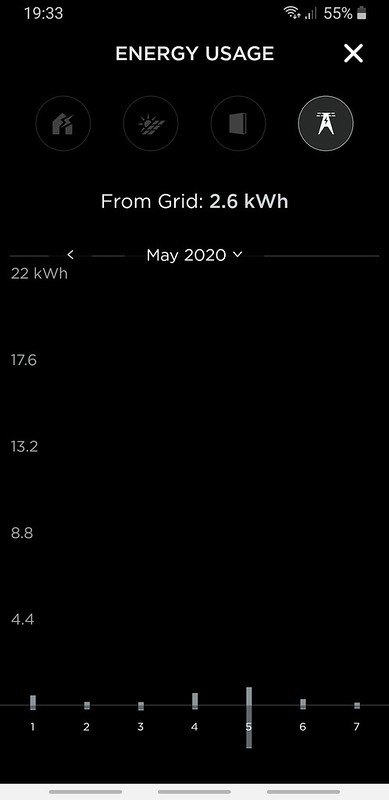tl;dr - for us, battery capacity made very little difference in cost savings.
How do you arrive at a fixed £ amount independent of the device spec? Or are you assuming "approximately the same capacity as a powerwall"?
It was based upon the capacity that we knew about the original Powerwall spec at the time and a few simplifications such as not taking into account power limits so was simplified but the answer that I was after was ballpark not exact - even if 100% out, it would be a useful number and it would have been far better than that - fact checked again my actual annual bill - its impossible to save more than my actual bill for the period. I was on a fixed tarrif so a simplified approach would have given an almost best case scenario.
The simplified approach:
Maximum stored PV excess for the day = deemed days solar export capped at capacity of the battery so 100% usage of excess solar - assumed 100% round trip efficiency and no charge limit (latter likely to have no effect as days when peak power limits breached would likely to exceed battery capacity limit)
Maximum stored energy reuse = measured days energy usage less maximum stored PV excess for the day - assumed no limit on import.
The above had very small difference in saving between a 4kWh battery and a 6.1kWh battery. Above the daily energy usage, size of battery had no effect. This however assumed that residual charge in the battery was lost at end of the day but this would be offset by the assumption that energy could be used before it was generated - averaging these out, there would not be much in it, but the larger the battery capacity, the larger the difference, but pretty minor.
I've just gone back and revisited the spreadsheet and done some what-if's on battery capacity. These values are based upon our energy usage - others will have different usage patterns. But i've put in our energy usage for that year, 2015. Figures were based upon 15p/kWh electricity price (we are less than that so current savings would be even less). Values also based upon CT clamp meaturing, so not that accurate at low power levels.
4kWp PV System, ~3360kWh generation, ~2060kWh calculated export (no export meter), 1830kWh imported (current ~2100 metered), at 2015 price/usage 0.15p/kWh = £308 (current price and usage 0.138p/kWh = £290). IF WE IMPORTED ZERO ELECTRICITY THESE VALUES REPRESENT THE MAXIMUM ANNUAL SAVING POSSIBLE THAT WE CAN MAKE. The figures predate EV charging so savings now potentially better.
What ifs...
Usable battery capacity (kWh) / £ per year export stored / £ per year saving at 15p/kWh
1 / £42 / £42
2.4 / £87 / £79
4.8 / £155 / £115 - probably best bang for the buck - a system may cost around £2300
5.8 (7.2kWh @80%)/ £178 / £120 - just added so not reflected in text below. System price around £3050.
7.2 / £210 / £121
10 / £257 / £121
14 / £292 / £121 - approx Powerwall spec at I believe around 9k installed.
20 / £308 / £121
System prices do not include installation
So based upon the above and our 2015 usage patterns, somewhere between 4.8 and 7.2kWh storage, delta savings converges to 0. So no cost saving to be had exceeding 7.2kWh storage - within caveats mentioned above. Sweet spot seems to be somewhere between 4.8kWh and 7.2kWh. We have gone 7.2kWh, 5.
Assuming cost saving of £121/year, 10 year payback of £1210 - the battery system that I have ordered is £3k give or take a few ££. So that on paper is not going to pay back even in 20 years which is not good as a 10 year life span is probably to be expected.
As a sanity check, this gives self consumption at around 80%, which is inline with many published values. So I am fairly confident that the simplified approach is within reasonable bounds.
However, at time of calculating, I took other factors into account, such as energy inflation (its actually deflated) and assumption that my figures were 100% out being generous to wanting to justify a battery system, the real saving for us is somewhere between these approx figures and £308 (currently £290). Now with EV charging, and ability to time shift in winter and possibly move to something like Agile (this will flatten the evening peak) these figures above will be lower than current usage patterns, but I suspect cost saving wise, our system will come in close to 10 year or less break even.
All above assumes 100% round trip efficiency.



